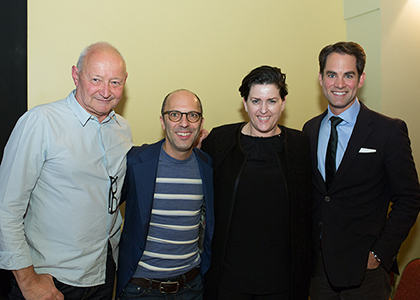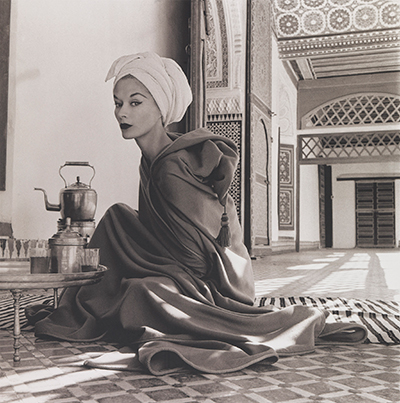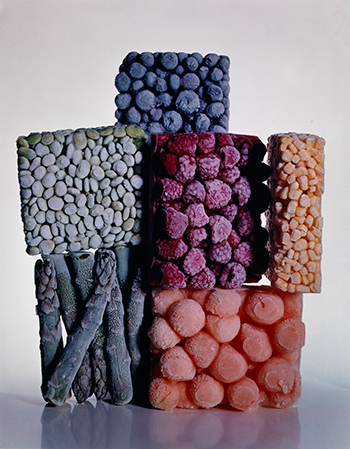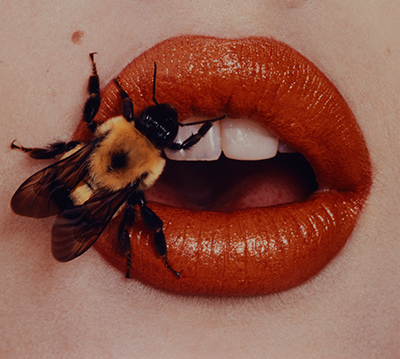Those who worked with photographer Irving Penn in his later career described that “when you walked around the studio you saw an 85-year-old man, but as soon as he gets behind the camera he’s like a 25-year-old boy.”

From left to right, Raymond Meier, Ivan Shaw, Charlotte Cotton and
Jared Bowen gathered at Lesley to discuss Irving Penn.
Penn, whose career spanned seven decades until his death in 2009, was the subject of a Nov. 3 discussion in Marran Theater featuring panelists from the photo, fashion and art worlds. We presented the event in concert with the “Irving Penn: Beyond Beauty” exhibition in our Lunder Arts Center and University Hall galleries.
“If you have to study one photographer, you have to study Penn, because you get all the answers there,” said panelist Raymond Meier, who is one of today’s most prominent fashion photographers.
Moderator Charlotte Cotton, who was curator of photographs at the Victoria and Albert Museum in London, led the conversation as the panelists delved into Penn’s innovation, his boundless energy, and his role in shaping 20th century fashion photography.
“What strikes home for me is that he was a revolutionary in his day,” said panelist Ivan Shaw, director of photography for Condé Nast Editions. “One editor said, ‘Penn, your pictures burn the page.’ What did she mean by that? His photos were destroying everything they perceived to be great photography at that time. ... I think it’s really important to remember that he changed everything.”
The panelists touched on the stages of Penn’s career, including street scenes from the late 1930s, photographs of the American South from the early 1940s, celebrity portraits, fashion photographs and still life images.
“The most amazing thing is he found a vision which didn’t get boring for 60 years,” said Meier, “and he could reinvent himself while staying based on the exact same principles.”

Irving Penn photographed his wife, Lisa Fonssagrives-Penn, in a
palace in Marrakech, Morocco, in 1951.
Penn was one of the first photographers to cross the chasm that separated magazine and fine art photography. His fashion and portrait photographs defined elegance in the 1950s, yet throughout his career he also transformed mundane objects, such as storefront signs, food, cigarette butts and street debris, into memorable images of unexpected, often surreal, beauty.
“He photographed debris and gum and cigarettes in New York that become sculpture,” reflected panelist Jared Bowen, the Emmy Award-winning host of the public television series, “Open Studio with Jared Bowen.” “He always stayed so true to the art.”
When Shaw first started working at Vogue in the early 1990s, he would go to Irving Penn’s studio to pick up his film, where he glimpsed Penn’s craft and got to know his staff and assistants.
“His studio was pretty extraordinary,” Shaw recalled. “It was such an honor. Of course, when you look back on the memory, you realize it’s even more important.”
Meier said Penn was a major inspiration for his career.
“In the beginning I was just fascinated by the cleanliness and the beauty of his photography,” reflected Meier. “Penn stayed with me actually my entire life, and even (though) I just met him twice briefly, I always felt extremely close to Penn.”
Penn’s career also created a pathway for success in commercial photography, said Meier, whose photos have been a fixture of Harper’s Bazaar, the American and international editions of Vogue, and The New York Times.

Irving Penn transformed mundane objects, such as
storefront signs, food, cigarette butts and street debris,
into memorable images of unexpected, often
surreal, beauty.”
“The interesting thing about Penn is that it’s not just his photography, I think it’s the whole package, the whole story,” noted Meier. “We can learn from Penn about art, about business, about how to create a legacy, how to set up a foundation and how to make a great contract with American Vogue and stay with American Vogue his entire life, really forming this friendship for 50 years.”
Changes in photography in the post-Irving Penn era
The panelists also wrangled with other subjects in the post-Penn era such as airbrushing, the decline of the publishing industry, and the challenges for today’s photographers amid ubiquitous, free online content and social media.
“I have friends bemoaning the fact that they’d be on shoots and hear, ‘Oh, let’s not bother touching up the lipstick. We can do that in post-production,’” said Cotton.
Meier lamented that re-touching has created forgettable photos that all “look the same.”
“There was a huge shift where the editors became stronger and stronger, and the photographers weren’t so much in control,” said Meier. “In the old times, even 10 years ago, the photographer was the dictator.”
In response to this, young female photographers are leading a renaissance, creating images with “intense naturalism” that counter the trend, Shaw said.
The panelists discussed the support that Penn’s studio afforded him, with a space, equipment and staffing all paid for by Vogue for more than 60 years – a support system that magazines no longer provide.
“You need money, you need good people, you need technical support and great printers – a whole line that has to be calibrated from the beginning to the end,” said Meier. “The support system, I would say, is very essential for a great photographer.”
Today, photographers enjoy the freedom and power to promote themselves without necessarily relying on a network of agents and major fashion publications, but the new opportunities are diminished by a dearth of financial support.
“It’s fine to talk about these kinds of choices, but it’s done from the position of the 99 percent where you have all the ideas but none of the capital,” said Cotton.

“If you look at work (Irving Penn) did in late career, I think it’s very
innovative and pushed boundaries,” said Ivan Shaw.
Penn photographed “Bee” in New York in 1995.
Resources aside, the panelists all agreed that Penn created timeless images and continuously approached his work with fresh eyes.
“If you look at work he did in late career, I think it’s very innovative and pushed boundaries,” said Shaw. “There are difficult images, like the screwdriver in the mouth beauty-image, that are still really challenging. There are some pretty radical images, not pictures he would have done in the 1950s.”
Added Meier, “What’s so amazing about his work is that he became a very conceptual thinking. It’s almost less the photography, and almost more the ideas.”
Shaw recalled Penn’s work with Vogue fashion editor Phyllis Posnick in the 1990s, when Penn was in his 80s.
“He had an incredibly prolific period in his late career,” said Shaw. “It’s a rarity to be as good or better than you’ve ever been. He never drops off. It still boggles my mind.”
Visit the exhibit
“Irving Penn: Beyond Beauty” is the first-ever major exhibition of Penn’s work in the Boston metropolitan area, and the exhibit’s only appearance in the Northeast. The show is drawn from the holdings of the Smithsonian American Art Museum and features nearly 150 photographs. It is on view at Lesley through Nov. 19. Visit today.